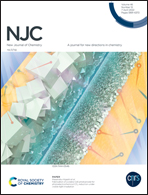Electrocatalytic proton reduction by dinuclear cobalt complexes in a nonaqueous electrolyte†
Abstract
A set of new class benzimidazole-derived dinuclear cobalt complexes, [CoII2(L1)2] (1) and [CoII2(L2)2] (2) as molecular electrocatalysts are employed in a homogeneous system for electrocatalytic proton reduction (where L1 = 2-{[2-(8-hydroxyquinolin-2-yl)-1H-benzimidazol-1-yl]methyl}quinolin-8-ol and L2 = 2-{[6-methyl-2-(8-hydroxyquinolin-2-yl)-1H-benzimidazol-1-yl]methyl}quinolin-8-ol). The catalysts 1 and 2 electrocatalyze efficiently in an organic medium with the addition of acetic acid to probe the catalysis resulting in 82–90% of faradaic efficiency for H2 evolution at an applied potential of −1.70 V vs. SCE. From the electrochemical responses, it was inferred that the methyl-substituted dinuclear analogue, [CoII2(L2)2], possesses more negative onset potential and an increased overpotential of 100 mV than its parent counterpart, displaying lower catalytic activity. Upon performing an open circuit potential test through the application of an external potential of −1.70 V and −2.10 V vs. SCE followed by further treatment with 24 equivalents of proton source, the initial species reverts to the CoIICoII state. No observable degradation of catalysts was observed during the process that ensures their high stability throughout the event.



 Please wait while we load your content...
Please wait while we load your content...